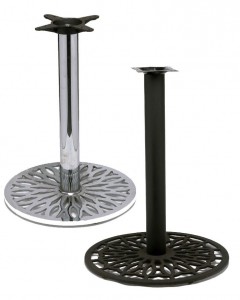 One of the first things customers do when shopping for restaurant furniture is to look at the dazzling array of options in restaurant table tops because there are so many beautiful options such as butcher block, granite, and laminate among many others. When shopping for restaurant tables, keep in mind some basic facts about the restaurant table bases that support the table tops.
One of the first things customers do when shopping for restaurant furniture is to look at the dazzling array of options in restaurant table tops because there are so many beautiful options such as butcher block, granite, and laminate among many others. When shopping for restaurant tables, keep in mind some basic facts about the restaurant table bases that support the table tops.
To properly match a base to a table top, the size and weight of the table top should be compared to a base that has the ability to support the table top. This ensures that your customers will be comfortable while seated at the table, and has a great impact on the safety of the customer. The ability of the table base to support the table is one of the most important factors when purchasing a commercial table base. This article covers some variables and general advice for customers shopping for restaurant table tops and bases.
Base quality
One of the most important factors customers need to look at when purchasing a table base is the quality. From the outside two bases may look about the same, but all bases are not created with the same quality. The thickness of the base column and the overall weight of the base determine how stable the table top will be. A base column constructed of 22 gauge steel will wobble much easier than a column constructed of 16 gauge steel. Of course, this all depends on the weight and size of the table top, and properly matching the correct size base to table size and style. Other parts of the base which affects the quality of the base are the top plate (also called a spider) which vary in quality, size and weight. Base columns that are not cut exactly at 90 degrees will cause table top lean. Base castings that are poor will not allow the base to tighten before the table top is applied.
Cross bases versus round bases
A cross base (also called an X-base) looks like an X on the bottom where the base sits on the floor. A round table base is constructed with a large round plate where it contacts the floor. Round bases are usually heavier and may be of better quality for certain table types as they have five points of contact with the table top instead of four points of contact with the cross base.
Long rectangular tables
When purchasing long rectangular tables, the table will be much more stable when matched with two t-style table bases rather than round or cross bases.
Cantilevers and post legs
Tables that are placed against the wall benefit customers by allowing more foot room, especially on booth tables where the booth seating is not moveable. Cantilever bases are attached to the wall and post legs are used at the end of the table to make the table solid enough so customers can push off of the booth table when exiting.
Ground mount or core drilled bases
Ground mount or core drilled bases allow for maximum foot room, but they are not moveable. Ground mount bases bolt to the floor and core drilled are set in concrete.
Regular glides and self adjusting glides
Regular glides are hand operated levelers on a base that need to be adjusted most every time the table is moved. Without frequent maintenance these glides tend to get lost or are not adjusted. Self adjusting glides are levelers that adjust the table to the floor. Most floors are not flat, so this is an automatic leveling device, so restaurant tables won’t wobble which saves staff labor time. Only a small fraction of restaurants use them however. Often customers sit at tables that have napkins, or some other impromptu leveling device to keep the table from wobbling. When tables wobble, it may lower the dining experience and customers may not return without letting restaurant management know why. It’s amazing how an inexpensive table base option can so powerfully impact a customer’s dining experience.
Special bases
Some table tops require a special custom made base by a metal fabricator. This includes over sized tables, extremely heavy tables, unusual bar height tables, extreme customer use or odd shaped table tops.
How to decide on what size base
Consult an experienced commercial restaurant furniture supplier, who will have the best advice on what table base size and style to use. If in doubt as to what size table base to use, it is usually better to purchase a more substantial base.
